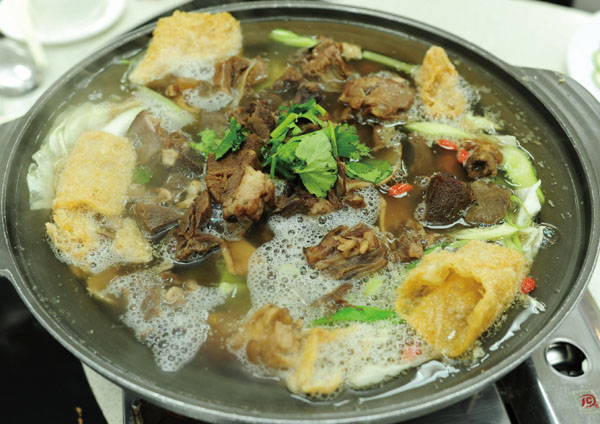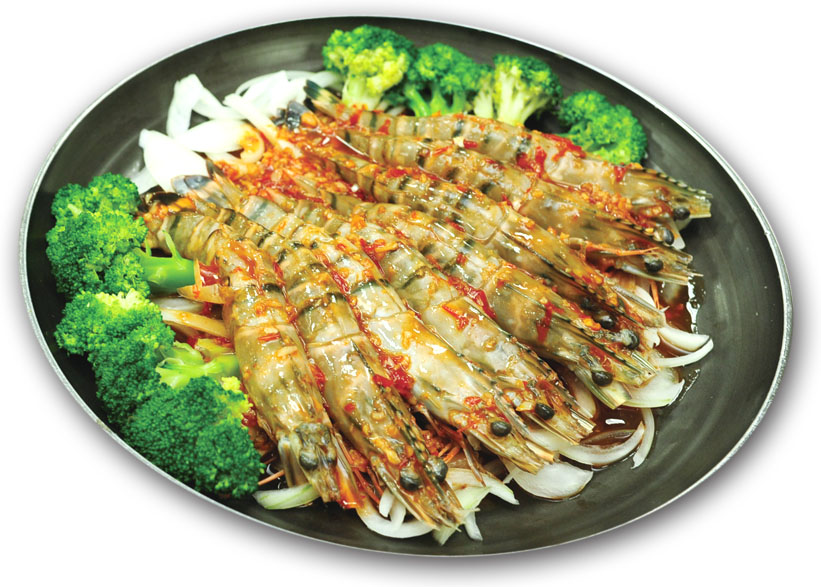An Aroma that Travels through Generations/萬里飄香 岡山豆瓣醬
An Aroma that Travels through Generations
Gangshan's Fermented Soybean Paste with Hot Pepper Sauce
◎English translation: Peng Hsin-yi
◎Photos by Pao Chung-hui
 Fermented soybean paste is a quintessential flavor in the food memories of a whole generation of Taiwanese. Its smell and taste tugs on the hearts and stomachs of every member of the family.
Fermented soybean paste is a quintessential flavor in the food memories of a whole generation of Taiwanese. Its smell and taste tugs on the hearts and stomachs of every member of the family.
In Taiwan, Kaohsiung City's Gangshan District is renowned for its fermented soybean paste. In fact, it's one of the district's "Three Treasures," the others being lamb stew and honey. But not many know the history of this beloved condiment.
Back in 1949, when the Republic of China government moved to Taiwan, the ROC Air Force Academy relocated to Gangshan. Along with the academy came air force officers and their families. Since many of them were originally from mainland China's Sichuan Province, they brought to their new home the flare of Sichuan (often spelled Szechwan) cuisine.
The oldest brand of fermented soybean paste in Gangshan is Chibin, and it really did start in a grandmother's kitchen. The current owner, Mr. Yuan Zhen-gang, says that back then, fermented soybean paste was not available in Taiwan, but his Grandma was able to replicate the taste from home.
Like all military families, they received monthly rations of grains and legumes from the government. Grandma Jin accumulated several months' worth of soybeans, and with a small amount of yeast she had brought with her from home, she managed to produce the first batch of paste in Taiwan. As word got around, neighbors started asking Grandma Jin to make some for them. It eventually became a family business. Mr. Yuan and his wife, Ms. Huang Siao-feng, both grew up watching Grandma Jin perform this labor-intensive process over the years, never deviating from the original recipe.
 That elusive "umami" in fermented soybean paste comes from the fermentation process. The proteins in soybean are transformed into amino acid, making it a delicious and nutritious addition to practically any dish.
That elusive "umami" in fermented soybean paste comes from the fermentation process. The proteins in soybean are transformed into amino acid, making it a delicious and nutritious addition to practically any dish.
The key to perfect bean paste is the fermentation process. First, the beans are rinsed and cooked in a steamer, then left to cool. Yeast is blended in after the beans have cooled to room temperature. The mixture is then kept in a well-ventilated room for seven days with the temperature controlled to 26 – 28 degrees Celsius (78.8 – 82.4 Fahrenheit), the optimal temperature for yeast growth. The beans are gently massaged by hand, to ensure each bean is coated with yeast, before being sealed in jars that stand in an open courtyard. The work does not stop there. Over the following 180 days, each jar needs to be stirred periodically. The bean paste is boiled and vacuum-packed into sterilized glass jars, finally becoming the condiment we are so familiar with.
Ms. Huang says good bean paste can hold its own without any embellishment. It is best to pair it with simple food. You simply use it as a dip with plain mantou (Chinese steamed bread). The bean paste is an indispensable partner to many culinary creations. If you eat lamb stew in Gangshan, the default sauce is fermented bean paste. It is also a wonderful companion to seafood; the salt and spice in it making fresh seafood taste even sweeter.
 Making bean paste the traditional way is backbreaking work, and at one point Mr. Yuan almost gave up. But he could not let go of the emotional bond tying him to the memory of Grandma Jin and his parents. He says he grew up "steeped in a bean paste jar". Instead of quitting, Mr. Yuan is planning to open a museum dedicated to his product, so that visitors to Gangshan can learn how a Sichuanese condiment became a Taiwanese favorite, and how a family's love for food became part of Gangshan's best offering to the world.
Making bean paste the traditional way is backbreaking work, and at one point Mr. Yuan almost gave up. But he could not let go of the emotional bond tying him to the memory of Grandma Jin and his parents. He says he grew up "steeped in a bean paste jar". Instead of quitting, Mr. Yuan is planning to open a museum dedicated to his product, so that visitors to Gangshan can learn how a Sichuanese condiment became a Taiwanese favorite, and how a family's love for food became part of Gangshan's best offering to the world.
| Chibin Fermented Soybean Paste |
| |
07-6281191
No.27-1, Jiahua Rd., Gangshan Dist., Kaohsiung City |
 萬里飄香 岡山豆瓣醬
萬里飄香 岡山豆瓣醬
◎文/陳美鳳
◎攝影/鮑忠暉
在許多台灣人的記憶中,阿嬤的灶腳總有一罐豆瓣醬,一打開它,香醇的幸福味牽動全家人的心,其中最知名的是高雄岡山豆瓣醬,是岡山名產三寶之一。
政府遷台後,空軍官校在岡山復校,定居岡山的軍官眷屬多為四川人,因此讓豆瓣醬有了連結的時空背景。以岡山老字號的志斌豆瓣醬為例,來自成都的晉奶奶為了養家餬口,在物資缺乏的年代,晉奶奶把每月配給的黃豆存到一定數量,用家鄉帶來的豆麴作菌種,製作四川風味的豆瓣醬。後來街坊鄰居要求幫忙製作,讓打著志斌名號的豆瓣醬,逐漸做出口碑。目前由第三代袁振剛、黃小鳳夫婦經營,看著奶奶對豆瓣醬的堅持,絲毫不敢懈怠,遵循古法手工製作,保留傳統的家鄉味。
 豆瓣醬主要原料是富含蛋白質的「黃豆」,經過自然發酵後釋放出氨基酸,不僅營養成份高,更是造就了豆瓣醬的獨特風味!製作好吃的豆瓣醬重點在麴菌發酵的步驟,首先是清洗及蒸熟黃豆後放涼,經過培菌七天,除了保持空氣流通,溫度要控制在26-28度,以免太冷或太熱破壞菌種。下缸前還要經過雙手搓揉按摩,讓菌種搓散並平均包覆豆子,才算培菌成功。接下來是入甕釀造,在發酵的180天使勁攪拌均勻每一醬缸,使其發酵至熟成,最後再經調味、煮沸、真空裝瓶與殺菌後,就是大家熟悉的豆瓣醬!
豆瓣醬主要原料是富含蛋白質的「黃豆」,經過自然發酵後釋放出氨基酸,不僅營養成份高,更是造就了豆瓣醬的獨特風味!製作好吃的豆瓣醬重點在麴菌發酵的步驟,首先是清洗及蒸熟黃豆後放涼,經過培菌七天,除了保持空氣流通,溫度要控制在26-28度,以免太冷或太熱破壞菌種。下缸前還要經過雙手搓揉按摩,讓菌種搓散並平均包覆豆子,才算培菌成功。接下來是入甕釀造,在發酵的180天使勁攪拌均勻每一醬缸,使其發酵至熟成,最後再經調味、煮沸、真空裝瓶與殺菌後,就是大家熟悉的豆瓣醬!
老闆娘說好吃的豆瓣醬在簡單的食材中,更能將豆瓣醬的魅力發揮淋漓盡致,例如拿一個白饅頭沾著吃,就讓人吮指回味!豆瓣醬對料理提味有畫龍點睛的功效,來到岡山品嚐羊肉,搭配在地的豆瓣醬,可說是絕妙組合。另外海鮮類與豆瓣醬也是超麻吉,濃醇的黃豆香能襯托出海鮮的甘美。
製作傳統手工豆瓣醬十分辛苦,袁老闆曾有放棄的念頭,但看著奶奶、父母一步一腳印,讓豆瓣醬產業在岡山生根,想到自己從小就是在醬缸長大的孩子,對於豆瓣醬總比別人多一份特殊的情感,為了發揚光大祖傳的豆瓣醬,未來將籌建「豆瓣醬故事館」,製作豆瓣醬不再只是一個生產活動,更是岡山文化的一部份。
| 志斌豆瓣醬 |
| |
07-6281191
高雄市岡山區嘉興里嘉華路27-1號 |